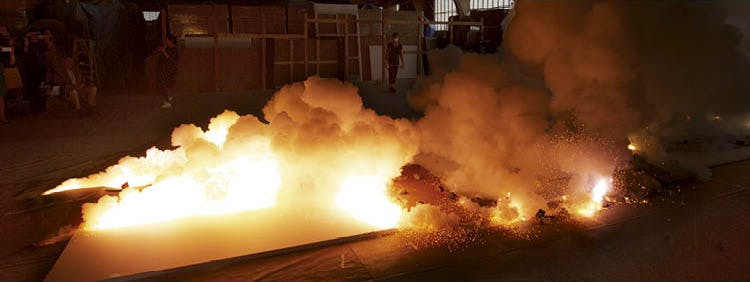
- Magazine Article
- Exhibitions
Explosive Stuff
Cai Guo Qiang, Cleveland, and the Cuyahoga River

Flash Point, Creation of the gunpowder work Cuyahoga River Lightning, 2018. © Cai Guo-Qiang (Chinese, b. 1957). Photo: Wen-You Cai, courtesy Cai Studio
Cai Guo-Qiang: Cuyahoga River Lightning marks the first time works by the acclaimed Chinese artist Cai Guo-Qiang are brought together in Cleveland. A star in the field of contemporary art, Cai choreographed the fireworks for the 2008 Beijing Olympic Games and has exhibited his ignited-gunpowder works in color at the Prado Museum in 2017 and the Uffizi in 2018. He did not hesitate to collaborate with the Cleveland Museum of Art on a project that commemorates a difficult moment in the city’s history: when the Cuyahoga River caught fire in 1969, and the remarkable recovery of its waterways. The challenge for Cai was to transform the event and the ensuing cleanup endeavors into the language of his art. His works on display offer an inspiring visual experience and new ways of perceiving humankind and our relationship to nature.

The exhibition borrows its title from Cuyahoga River Lightning: Drawing for the Cleveland Museum of Art, which Cai ignited in the presence of a group of museum members last year. Cai chose to depict an aerial view of the river from the bend where it burned to the point where it feeds into Lake Erie and emphasized its meandering by extending the river beyond the canvas. Additional gunpowder amassed at the stretch of the river where the fire took place left a dense conglomeration of burned, dark spots and sparks, marking an increased intensity of the fiery ignition. Cai sees the Cuyahoga River as a dynamic artery through the city, and in the sense of traditional Chinese medicine, he compares the course of the river to a path through which vital energy (qi) flows. Stagnation of its flow causes illness. In other words, if the river water is stagnant and polluted, the city lacks the life energy to prosper and thrive.
Another large-scale work, Last Carnival, demonstrates Cai’s recent foray into colored gunpowder. The work, which allows visitors to view and understand the exhibition in its larger, global context, can be read in many ways. At first it appears abstract, colorful, and impressionistic. Wild animals, including bears, lions, pandas, elephants, wolves, giraffes, and gnus, gather around a small, blue pond at the center of the composition. Chubby cherubs—purveyors of love—rejoice in the sky. The color scheme and the baroque-style cherubs are inspired by paintings Cai had studied in the Prado.

Looking closely, Last Carnival reveals some disturbing and alarming scenes. The animals mate and play, although in many cases with other species, as a cherub mates with a fish—a taboo of nature. The second panel on the right shows a dark purple mushroom-shaped cloud or whirlwind in the background, a feature that may be read as an approaching tornado. Also, the pond appears proportionally too small to supply the animal world with sufficient water. The artist associates this scenario with our indifference to facing the perils of climate change and a planet in revolt.
According to Cai, the animals and cherubs, representative of human society, continue to mate, play, and party while the planet disintegrates and the water supply decreases. He calls the ignorance and behavior of humans a “deep tragedy.”
In contrast, the third gunpowder work in the exhibition, Pine Forest and Wolf, is monochrome and presents nature in harmony with wildlife in the spirit and sense of traditional Chinese landscape paintings. Varying shades of black and brown have been achieved by covering parts of the canvas with stencils or fuses that impact the oxidization process during ignition.
This work was generously donated to the Cleveland Museum of Art in 2006 by museum trustee Agnes Gund. Closing the exhibition, the drawing offers a positive and idealistic image of man and nature existing harmoniously. In a world troubled by natural disaster and the existence of climate change caused by human behavior, Cai’s powerful works inspire awareness and encourage action to help protect our endangered environment, both locally and globally.

Cleveland Art, May/June 2019